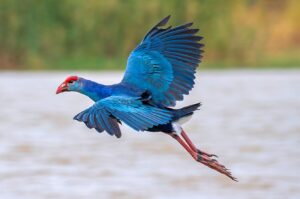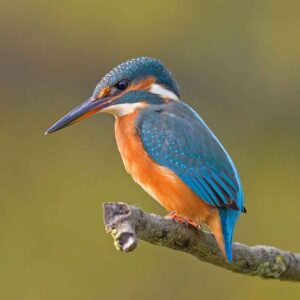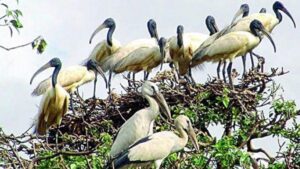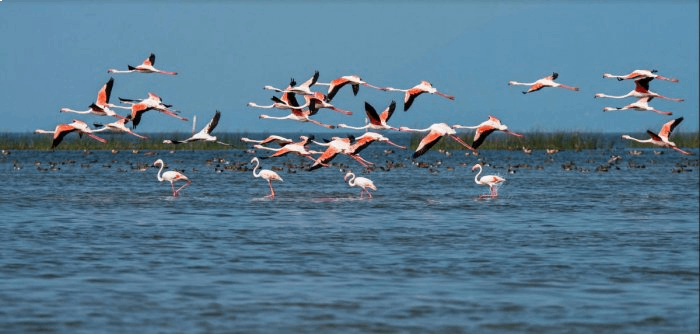Best lakes in India for birding enthusiasts
Lakes, in particular, are a paradise for birding enthusiasts as they provide the perfect ecosystem for millions of migratory birds each year. Although there are several national parks across India where birds of different species can be viewed, these five lakes are ideal playgrounds for nature lovers who just want to be armed with a pair of binoculars and a camera to take aesthetic pictures in a serene, stress-free environment. The mesmerising calls of songbirds provide a welcome escape for many from the noisy, corporate buzz of city life.
Sat Tal Lake

Sat Tal boasts a variety of colourful bird species, such as the Kingfisher
Sat Tal (“seven lakes”) is a cluster of seven interconnected freshwater lakes in the Nainital in Kumaon region of Uttarakhand. It sits at an altitude of 1370 meters above sea level and is set amidst dense forests of pine and oak trees. The destination boasts pleasant weather throughout the year, which makes it a comfortable serene get away for any season.
Sat Tal is known for its wide range of avian fauna that includes 500 species of resident and migratory birds, such as the colourful Kingfishers, red-billed blue magpie, plum-headed parakeet, Eurasian jay, and the critically endangered red-headed vulture. There is also a variety of unique biodiversity such as 525 butterfly species such as Indian fritillary and Paris peacock, fish, and plants like bryophytes and orchids.
Recently, the cluster of lakes and its surrounding area has been embroiled in controversy because of a re-development plan by the Uttarakhand government, who are planning to build a library, children’s park and shops in the area. There are local protests against this as it would damage the nature of a region that has already been ravaged by fires and dying springs. An online petition to ‘Save Sat Tal’ and declare it a conservation reserve has already garnered 32,000 signs.
Vembanad Lake

Colourful parrots perched on a branch at Kumarakom Bird Sanctuary (Photo: Tour My India)
Situated on the banks of Vembanad Lake in Kerala, which is also the longest lake in India at 96.5 km, the Kumarakom Bird Sanctuary is home to an array of some of India’s most striking local birds such as the waterfowl, Brahminy kite, and snakebird, and migratory species that flock in thousands mainly from the Himalayas and Siberia such as flycatcher, tern and the Siberian stork.
The sanctuary is spread across 14 hectares. Birders visiting in June and August can get treated to a number or rare species as it is the breeding season of resident wetland birds such as Indian Darter, Little Cormorant, different species of Egrets and Herons, and White Ibis.
The quaint nearby village of Kumarakom is a short boat ride away, where tourists can enjoy the thick mangrove forests, lush paddy fields surrounding the tranquil Kerala backwaters.
Nal Sarovar Lake

A beautiful Purple moorhen takes flight (Photo: Hitesh Parmar)
The largest wetland bird sanctuary in Gujarat, Nal Sarovar Bird Sanctuary is surrounded by a large lake, tall grasslands and marshes, and attracts a myriad of exotic migratory birds that fly in from as far as Siberia, Oman and the UAE. Millions of birds visit the sanctuary in the winter and spring, including the purple moorhen, white storks and flamingos. Boats leave at sunrise to take tourists birdwatching, which is the best time to catch sightings of the rarest or their favourite species.
An interactive interpretation centre called ‘Abhiruchi Kendra’ was developed in the sanctuary by the forest department, where 225 types of birds have been recorded so far.
Lake Chilika

Nalbana Bird Sanctuary at Lake Chilika
Spread over the Puri, Khurda, and Ganjam districts of Odisha, Lake Chilika is the largest wintering ground for migratory birds on the Indian sub-continent. Chilika Lake is also Asia’s largest and the world’s second-largest lagoon after the New Caledonian barrier reef. A curious feature of Nalbana Island is that it disappears during the monsoon due to inundation, and emerges again post-monsoon.
Nalbana Island was declared as Nalbana Bird Sanctuary under the Wildlife Protection Act in 1972. The picturesque sanctuary is especially famous for its abundance of long-legged waders; birders can see the large flocks of pink greater flamingos that come from Iran and Gujarat. Others include the Goliath heron, black-headed ibis, and the extremely rare Dalmatian pelican and peregrine falcon, and the endangered Irawaddy Dolphins.
In 2018, the Odisha government inaugurated the National Chilika Bird Festival, which aims to improve tourism and put Chilika on the global tourist map. It takes place on January 27 and 28 each year with numerous activities like bird watching trips, workshops, photography competitions and promotional stalls.
Manasbal Lake

The striking Indian Golden oriole can be spotted at Manasbal Lake (Photo: Avinash Sant)
Manasbal Lake, which has been given the sobriquet of “supreme gem of all Kashmir Lakes,” is located in the Ganderbal district in the state of Jammu and Kashmir and with a depth of 13m, is the deepest lake in India. The large bloom of lotus flowers at the periphery of the lake gives a beautiful touch to its pristine blue waters. The lake is also overlooked by The Mughal garden, called the Jharokha Bagh. It is also one of the largest natural stamping grounds of aquatic birds in Kashmir.
The area around it is a wildlife photographer’s paradise, as several species of gorgeous, colourful birds can be spotted, such as the Eurasian hoopoe, common and white-throated Kingfisher, European roller, and Indian golden oriole.
Tourists can also enjoy a range of other activities such as boating, fishing, and water skiing, which is ideal due to the lake’s surface sheen and long length. However, there has been some discussion regarding whether the lake should be preserved for sustainable tourism rather than disturb the serenity of the lake. Moreover, ornithologists say that many bird species are under tremendous pressure due to habitat loss, so a more environmentally sensitive form of tourism would benefit the biodiversity of such areas.










